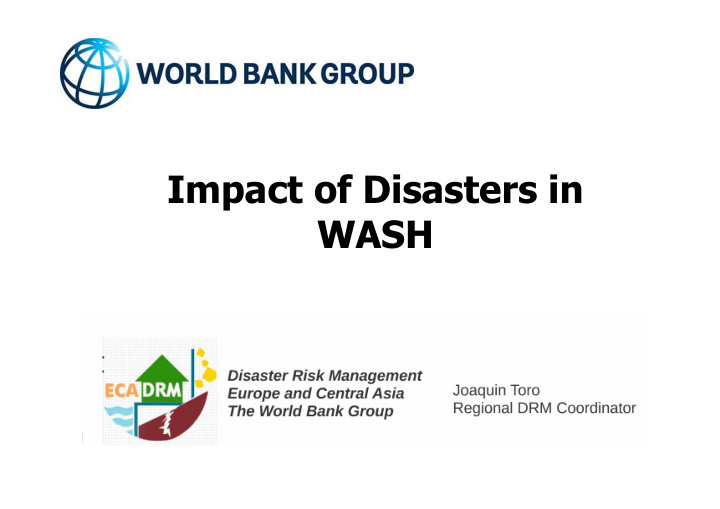



����������������������� ����
Disasters Reported Disaster summary 1975 -2013
Fatalities Disaster summary 1975 -2013
People Affected Disaster summary 1975 -2013
Disaster summary 1975 -2013
Disaster summary 1975 -2013
Impacts of Disasters in WASH
Hurricane Katrina 2005 More than 1,000 drinking water systems and 172 sewage treatment plants were damaged, leaving 2.4 million people without access to safe drinking water.
Haiti Earthquake 2010 A cholera outbreak affected more than 470,000 Haitians and killed 7,000. It marked the first cholera outbreak in that country in more than a century.
Peru Earthquake 2007 Damages to the water and sanitation systems with a total amount of US$ 30 million. This money could have been used to install over 8,183 water connections and 7,925 drainage systems to benefit 160,888 inhabitants.
Japan Earthquake 2011 An estimated 1.4 million households in 14 Prefectures have no access to water. “Fully restoring water and sewer services to the town of Sendai will take three to five years” Water contamination – Complex Disasters
Balkans May 2014 floods
Maximum number of Municipalities affected in BiH
Summary of disaster effects BiH
Flood-related damage to the water supply and sanitation infrastructure in affected area was relatively limited. In the case of water supply systems, physical damage was mainly limited to • electrical components and equipment in pumping stations or water treatment plants; • administrative and laboratory buildings, and office equipment, records and laboratory equipment and • motor vehicles, that were exposed to the water over an extended period of time. In the case of wastewater structures, damage was linked to • electrical components in pumping stations, • administrative buildings and • manhole covers, waste containers and similar elements.
Serbia-affected municipalities
Summary of disaster effects Serbia Disaster Effects, million EUR Damage Losses Total Social 234.6 7.1 241.7 Housing 227.3 3.7 230.9 Education 3.4 0.1 3.5 Health 3.0 2.7 5.7 Culture 1.0 0.6 1.6 Productive 501.0 569.4 1,070.3 Agriculture 107.9 120.1 228.0 Manufacturing 56.1 64.9 121.0 Trade 169.6 55.2 224.8 Tourism 0.6 1.6 2.2 Mining and energy 166.8 327.6 494.4 Infrastructure 117.3 74.8 192.1 Transport 96.0 70.4 166.5 Communications 8.9 1.1 10.0 Water and sanitation 12.4 3.2 15.7 Cross cutting 17.2 10.6 27.9 Environment 10.6 10.1 20.6 Governance 6.7 0.6 7.2 Total 870.1 661.9 1,532.0
The main damages to water supply and waste water disposal systems were: • the piped network for both water and sewerage, including blockage of the sewerage system; • electrical components of pumping systems, especially at water sources such as well fields; • wells in urban areas, which were destroyed; • wells and intakes in rural and urban areas were clogged with sediment for the floods water; • One lagoon for sewage treatment was flooded and filled with sediment. The main damages within the solid waste management systems comprise: • damages and destruction of waste containers; • damages to the waste collection vehicles; • damages sustained at the solid waste disposal sites.
Exposed to most natural hazards and with accumulated vulnerability
What is Risk? Geological HAZARDS
Understanding the risk of your system/network
Linkages with other sectors Geological Institutions Civil Protection Hydro-Met Agencies Health Sector Transport Energy Public Works Education
REDUCING AVOIDING EXISTING CREATING RISK NEW RISK Resilient Resilient Society Society RESPONDING & RECOVERING MORE EFFICIENTLY TO DISASTERS
Disaster summary 1975 -2013
Disaster summary 1975 -2013
Recommend
More recommend